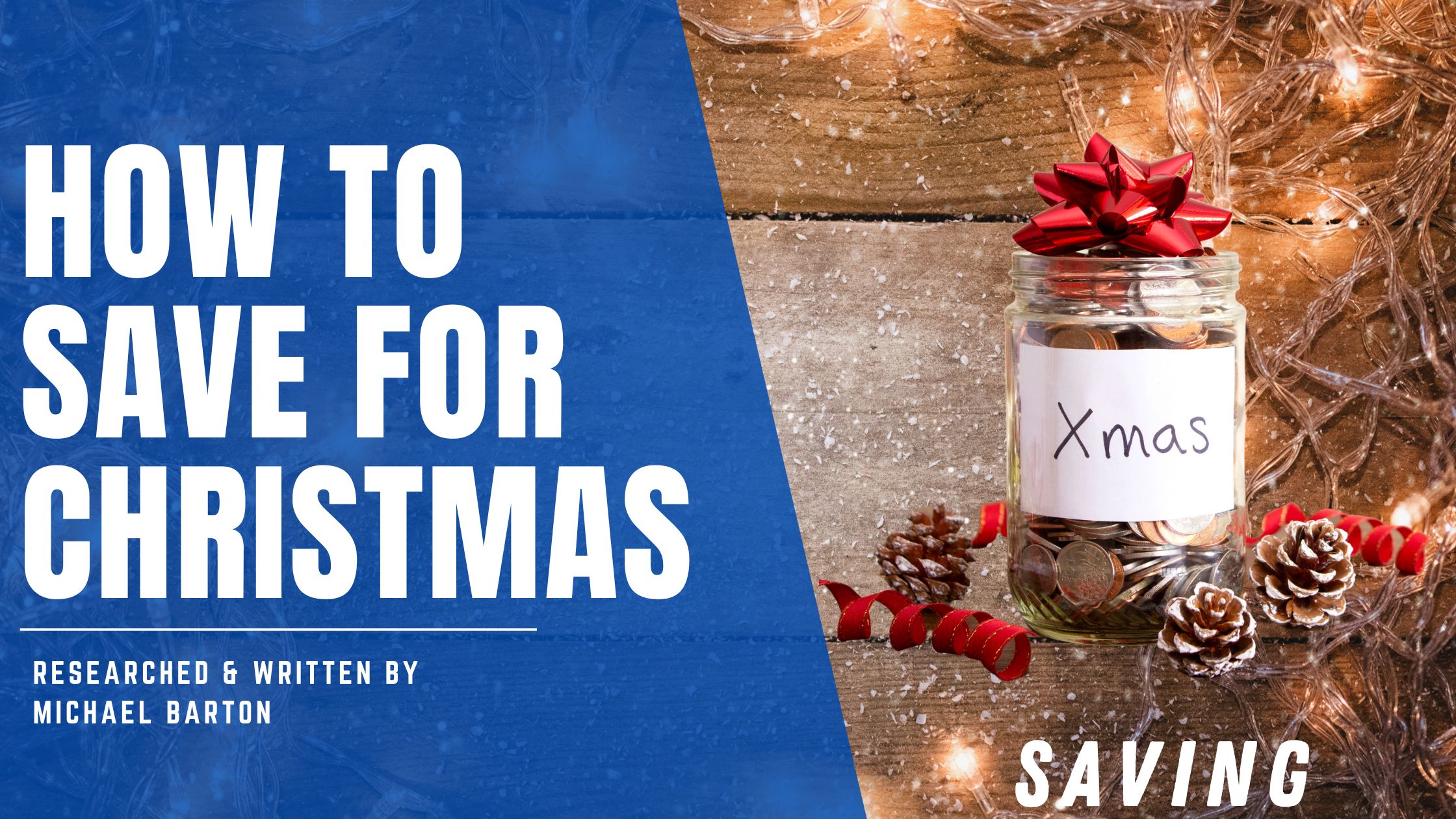Christmas is supposed to be a joyous time… if only you could rid the financial stress and worry it brings. Too early to think about it? Financial expert Michael Barton shares some advice on how to save for Christmas and you should be starting right now.
Do you reach December and start panicking about just how much the festive period is going to cost you? Then, after the event, you never have enough money to take advantage of all those fantastic sales, do you?
I hear you. I used to be the same. Then I was taught a few simple tricks that eliminated all the financial anxiety that Christmas brings to so many.
I’m going to share these tips with you now. First, with how to budget and save for a debt-free Christmas. Then with tips to save money on all your Christmas spending.
You’ll never have a pauper’s Christmas and New Year again!
Budget for Next Christmas’s Blowout!
How much will you spend on your next Christmas shopping bill?
It’s easy to get carried away and overspend. We make more impulse purchases in December than at any other time of year. Whether this is on food and drink or gifts, these impulse purchases can destroy all your good intentions.
The best time to make a budget for next Christmas is immediately after this one. While all the wasted food and drink is fresh in the memory. When your bank statement is in the red, and the pain isn’t a fading memory.
Start by making a shopping list. This time, make it realistic! It’s a few days of indulgence, not a month’s supply of groceries you need to cater for.
Decide on Next Christmas’s Gift Budget ASAP
Just after Christmas is the best time to decide how much you will spend on next year’s gifts. It’s when you should sit down and think about how much this year has really cost you. While the expense is raw – for you and your friends and family.
Figure out how much you can afford to spend, and on whom you want to spend. When you’ve done this, pluck up the courage and talk to your friends and family. Now is the time to do it, though.
Most will be in the same boat as you, and probably feeling embarrassed to discuss their situation. Most will be relieved that you’ve broken the ice, and happy to set realistic gift budgets for next year.
7 Christmas Savings Challenges
Now you know how much next Christmas is going to cost. A lot, right? No wonder you’re as poor as a church mouse at the beginning of every year.
If only you had the money saved to cover the cost of Christmas, and not expensive credit card debt to repay.
What you need is a savings challenge that will build a Christmas, and here are seven of the best.
1. Save Monthly
This is the easiest challenge to put into practice. Simply divide your total Christmas budget by the number of months between now and December. For example, if it’s June you’ll have six months (June, July, August, September, October, November). This is how much you need to save per month.
All you need to do is open a savings account (you can usually open a savings account alongside your current account) and transfer the money by automated regular payment on the day you get paid (before you have a chance to spend it).
The sooner you start, the lower the monthly savings amount.
2. The 1p Challenge
This is a great way to save £667.95 in a year.
On day one, you save a penny. On day two, you save 2p. Day three, 3p, and so on. On the last day of the year, you’ll add £3.65 to your savings pot. You can adapt this to suit you. For example, instead of putting money by each day, save weekly. It’s all in our article ‘Turning Pennies Into Pounds With the 1p Challenge’.
3. The No-Spend Challenge

This is one of the most difficult of saving challenges. It’s also one that will teach you most about how you are spending your money.
The idea is simple. Don’t spend any money except on essentials for a set period:
- Don’t have a cheeky beer three times a week
- No takeaways
- No dining out
- No sweets or snacks because they are on the shelf near the checkout
- No spending on clothes, or shoes, or bags
- No cinema visits or other entertainment
To be successful with this, you should prepare yourself and others first. Let your friends and family know that you plan to stay in for however long your challenge lasts (a weekend, a week, a month – the choice is yours). Borrow a good book or three to read. Stop browsing online shopping sites.
At the end of your no-spend period, put all the money you saved into your savings account. Repeat this until you have your Christmas budget put by.
4. Use Roundups
Not so much a challenge, perhaps, as a new way of spending. I like this because it is easy to do, and you don’t miss the money you are saving.
The way this works is that every time you use a card to spend money, the amount is rounded to the nearest pound and the difference is added to a savings account. For example, if you buy a coffee for, say, £2.25, the debit on your card will be rounded to £3, and 75p will be added to your savings account.
How much could you save using roundups?
This depends on how you use your card, but Moneybox (one of the apps that provide a roundup service) says that the average amount saved is £8.41 per week ─ more than £435 per year, without thinking.
5. Weekly Temperature Challenge
This is a fun challenge to do. At the end of each week, review the highest temperature recorded in your region during the last seven days. Convert this into pounds (25oC = £25, for example), and deposit this into a savings account, or put the cash into a savings jar.
You never know how much you could save this way. (It’s also a great savings challenge to take on to save spending money for your next summer holiday.) If you feel you can’t do this challenge every week, you can adapt it to save fortnightly or monthly.
6. Earn With a Side Hustle
If you have the spare time, why not turn a passion into profit? Using your skills, personality, and knowledge to make money can be highly rewarding. You never know, your side hustle could become your main source of income, which is exactly how Wallet Savvy’s founder Jason Mills started a business that now turns a six-figure annual profit. My own business started as a side hustle, too.
There are hundreds of side hustle ideas you could choose from. Take a look at Jason’s article ‘Side Hustle Ideas’ to get your entrepreneurial juices flowing, and deposit all the profits in your Christmas savings account.
7. The £1 Challenge
This is my personal favourite. It’s a little like the 1p Challenge, but starts by saving £1 in the first week and then increasing the amount saved by £1 each subsequent week. In the last week of the year, you’ll save £52, for a grand total of £1,378!
It’s a great way to develop a savings mindset. I like the way that it gradually builds up how much I am saving. This makes it easier to convert my spending to savings. Instead of going cold turkey on spending habits, you slowly transform them into a saving habit.
If you’re paid monthly, like I am, you can put your £1 Challenge money into your savings account when you get paid. Make sure you do this on the day you get paid before it becomes spendable money.
There’s something else I really like about this challenge. How it primes you to really ramp up your savings the following year.
By sticking to this challenge, you will have reduced your monthly spending. You’ll have eliminated those unnecessary and expensive impulse buys that are the root cause of so many financial woes. You won’t have the Christmas debt overhang that punishes you every New Year – and often for several months after.
With no Christmas credit card debt to repay and a better attitude to spending, you will now be set to take your saving to the next level. You’ve just saved £52 in Christmas week. How about saving £52 every week next year? Now your savings are switched to high heat, and you’ll be on course to save £2,704 over the twelve months following your successful £1 Challenge.
Cut the Cost of Christmas Without Scrimping
Undertaking a Savings Challenge isn’t the only strategy to make Christmas more affordable. You can also save on the cost of Christmas with a few cost-cutting strategies, and still have the festive period you desire. Here are eight Christmas cost-cutting tips you can put into action from today.
Make Secret Santa Gift Giving a Family Tradition

Here’s something that my family does whenever we get together at Christmas. We focus our gift spending on the children.
As grandparents, my wife and I focus on our grandchildren. This doesn’t mean the adults can’t have a bit of fun opening presents, though.
Instead of spending a few quid on everyone around the Christmas tree, we hold a Secret Santa. We’ll pick a theme. Each adult who will be present must then buy a present for one other (picked out of a hat – or virtual hat – well before the day) with a fixed budget (this could be £5, £10, £25, or other amount decided). Opening the presents and trying to guess the gift-buyer is a lot of fun, and it hasn’t broken the bank.
Buy Early & Often
You know that Christmas shopping list you made? You can start filling it early, and keep what you buy in a ‘Christmas cupboard’. Here are a few examples:
- Buy a bottle of spirit each month – they aren’t going to go bad!
- Christmas cards ─ they’re cheap to buy in January and in the shops from around September! Spread the cost by buying a few each month as we get closer to the big day, or send ecards, using a service like Jacqui Lawson.
- Christmas wrapping paper – like Christmas cards, the best time to buy is immediately after Christmas, and spreads the cost in the few months before Christmas.
- Non-perishables – take a look at your shopping list. What non-perishables or long-dated items can you buy throughout the year? Make a list of these, and buy gradually.
Buy Your Christmas Meat in September/October
One of the worst-kept secrets in the world must be that food prices rise as we approach Christmas. The best way to avoid these higher prices is to buy as early as possible. This is especially true for meat.
Make space in your freezer, and store a ham or beef joint, bacon, sausages, and more from around the end of September. Not only will you save money, but you’ll also buy the best joints without the fear of empty shelves.
Get Ahead of the Curve with Gift Buying
This tip won’t necessarily save you money. It will ensure you give the presents that your loved ones want.
Start asking what people want for Christmas early. September is perfect. It focuses minds and you’ll get the first dibs on what you buy. When you know what is on a Christmas wish list, decide when you will buy the present of your choice. I’ve found that Black Friday sales can save a pretty packet.
Buy Secondhand & Add a Little Love
Think back to when you were a kid. It’s time to be honest. How many of the hundreds of presents that you received can you remember?
Lasting memories aren’t made by the presents you open. They’re made by the experiences you have. You remember the time spent with family and friends. But there is the occasional gift that leaves an indelible mark.
I can remember two such gifts in particular. A garage for my toy cars, handmade by my oldest brother who didn’t have the money to buy the ‘real thing’ at the time. The second was a bike. Bought second-hand by my parents. Worked on for weeks by my dad, in the shed at the end of our garden. Hand-painted, with a unique set of stickers on the metal frame.
Pay for Christmas with Rewards Cards
With all the food, drink, and gifts you buy, it’s little wonder that Christmas is the most expensive time of the year for most of us. Even if you are planning to jet away from it all, holiday prices are higher during the festive holidays than most other periods.
You’re going to spend a lot. Why not earn money – or other rewards – as you spend? Most cards give either cashback or points that you can exchange for vouchers or spend with partner retailers. Some of the best rewards deals include those cards offered by Amex, Ada, and Chase Bank.
Shop Around, Use Discount Tokens and Voucher Sites
Always shop around before buying gifts. Look out for and save discount tokens to redeem at the till or online checkout. Use loyalty programs like Nectar to take a chunk out of that big Christmas food shop.
Whatever you wish to buy, it is worth visiting voucher sites like Wowcher and Groupon – you can get some tremendous deals that allow you to give premium gifts at high-value-for-money prices.
Wait Until the New Year Sales for Your Partner’s Presents
Your biggest single expense at Christmas is likely to be the present(s) you buy for your partner. It’s the classic way of showing how much you love them.
Not exchanging gifts between partners is becoming more popular. So, too, is delaying the gift part of Christmas. Instead of presenting a gift on Christmas Day, why not either delay the present buying until after Christmas, when the New Year Sales could save you 25% or more? If you have a fixed amount of money in mind for your partner’s gift, you might also consider presenting a voucher for him or her to spend in the New Year.
To Have the Best Christmas, Start Saving Today
Christmas should be a time for family and friends to get together and celebrate. It should be a time of fun, laughter, and merriment. It shouldn’t be marred by niggling money worries. You shouldn’t be anxious about the New Year and how you will afford your bills and pay for the presents that you put on credit.
Yes, Christmas is the most expensive time of the year. However, with a little planning, a little effort from today, and a strategy to save toward the year’s major event, there is no reason why you shouldn’t make next Christmas your best and least stressful yet.
Let us know how you plan to save for Christmas. We’d be pleased to hear your experiences.

